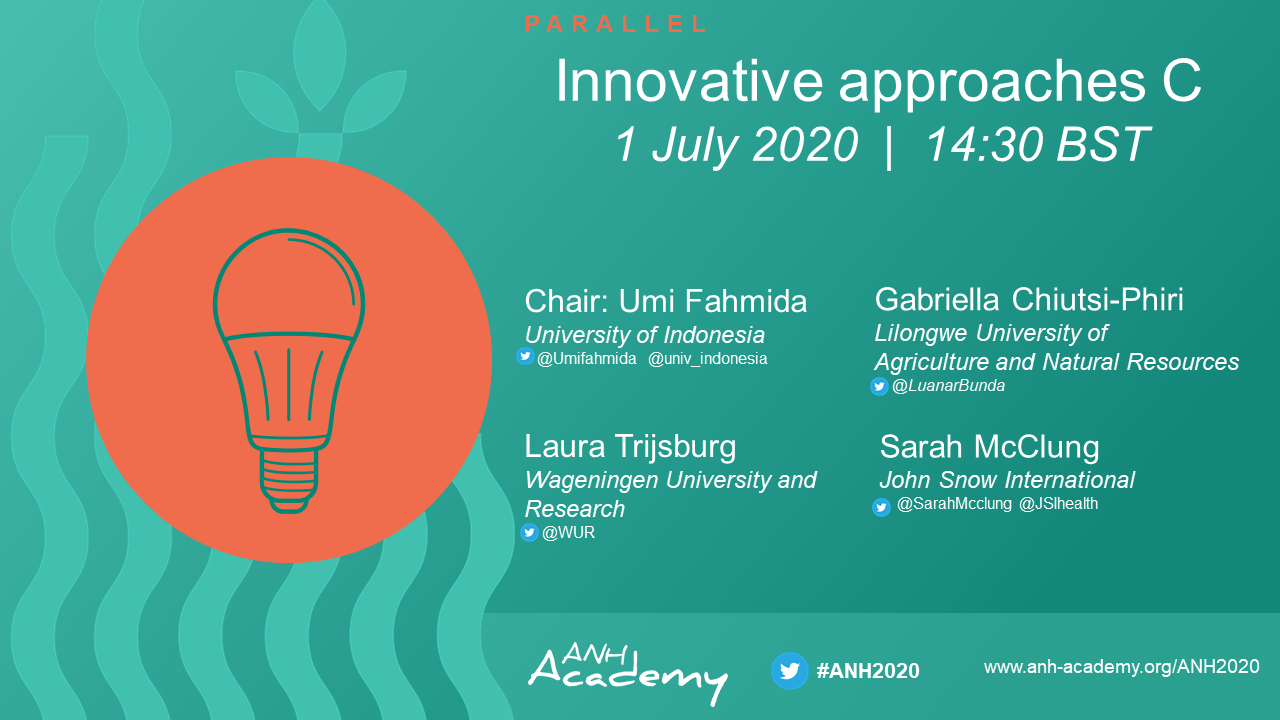
Intro animation:
Session recording:
Speakers and presentations:
-
Session chair: Umi Fahmida, University of Indonesia
@Umifahmida @univ_indonesia -
Gabriella Chiutsi-Phiri, Lilongwe University of Agriculture and Natural Resources
@LuanarBunda
Intensive sensitisation a key to successful community based research: Lessons from an agriculture-to-nutrition trial in rural Malawi
Presentation | Slides -
Laura Trijsburg, Wageningen University and Research
@WUR
Development and evaluation of the WISH Diet Index, a globally applicable diet quality index for sustainable food system
Presentation | Slides -
Sarah McClung, John Snow International
@SarahMcclung @JSIhealth
Not your usual survey: Using unexpected tools to advance understanding of the role of markets to improve young child nutrition through egg consumption in Tigray, Ethiopia
Presentation | Slides
Abstracts:
Intensive Sensitisation a Key to Successful Community Based Research: Lessons from an Agriculture-To-Nutrition Trial in Rural Malawi
Gabriella Chiutsi-Phiri1
Alexander A. Kalimbira1
Joseph Mfutso-Bengo2
Kate Millar4
Limbanazo Matandika2
Patson C. Nalivata1
Zione Kalumikiza1
Leonard Banda1
Jellita Gondwe5
Jo Sturgess3
Martin R. Broadley4
Edward J.M. Joy3
1Lilongwe University of Agriculture and Natural Resources, Lilongwe, Malawi
2College of Medicine, University of Malawi, Blantyre, Malawi
3Faculty of Epidemiology and Population Health, London School of Hygiene & Tropical Medicine, London, WC1E 7HT, UK
4School of Biosciences, Sutton Bonington Campus, University of Nottingham, Loughborough, LE12 5RD, UK
5Community Health Sciences Unit, Lilongwe, Malawi
Introduction
Community-based trials provide valuable evidence to assess the effectiveness of agriculture-to-nutrition interventions. The Addressing Hidden Hunger with Agronomy (AHHA) trial was conducted in rural Kasungu District, Malawi from July to September 2019. In this community-based, randomised, controlled trial, participants received selenium biofortified or control maize flour for 12 weeks, with blood samples taken at baseline and endline. This study considers (1) the challenges faced in trial implementation, including gaining the trust of participants and the wider community, and (2) the importance of formative research and the adoption of enhanced community sensitisation approaches for successful completion of the trial.
Methods
Successful implementation of the AHHA trial required the willing support of participants and the wider community. Risks were identified, e.g. that participants might sell or share their assigned flour with other households, or that people might decline to participate due to fear of providing blood samples. Formative research was conducted one year before the baseline survey to gauge these risks and identify mitigating strategies. We conducted a survey with 50 adult women, 6 Focus Group Discussions (FGDs) with adult men and women and 12 Key Informant Interviews (KII) with stakeholders ranging from the District Nutrition Officer to a Village Chief. Descriptive statistics were used to analyse the quantitative survey data, while FGD and KII data were analysed using qualitative methods. The formative research findings guided key implementation decisions, including the adoption of an enhanced community sensitisation approach. Community sensitisation was conducted by the project team and started with awareness creation among key district officers, traditional authority leaders and heads of all villages in the project catchment area. Subsequently, community sensitisation was conducted through village gatherings prior to household listing and baseline survey, and at three timepoints during maize flour distribution.
Findings
Survey participants typically ate all their previous days’ meals at home, although 16% reported eating at another household or restaurant. This was consistent with FGD findings, e.g. “It’s rarely that we share with our neighbours”. Thus, it was considered feasible to randomise allocation to treatment at household level provided participants understood that trial flour should be eaten at home. FGD and KII participants raised concerns that the biofortified flour might affect fertility, that blood sampling might be linked to witchcraft (“Maybe blood sampling has to do with Satanism”) and that participants might be subject to social stigma if community members considered them lazy for receiving free flour. However, mitigating strategies were proposed including community dialogue (“…every new thing it’s received with some doubts. People talk because there’s no information. If people have information and have everything, it clears out those misconceptions”) and the involvement of Malawi government partners, especially health extension workers. These suggestions were taken on board with regular village gatherings as part of an enhanced community sensitisation approach. Ministry of Health nurses were employed to collect blood samples, and all Research Assistants in the field were informed on Frequently Asked Questions to ensure the community received consistent information.
Conclusion
The AHHA trial is now complete providing a chance to reflect on its implementation. Nearly all (99.9%) the randomly sampled households agreed to recruitment and provision of blood samples, and 96% of participants completed the trial. These figures suggest that the community sensitisation was successful. From the experience of the AHHA trial, community sensitisation guided by formative research is an essential component of successful delivery of community-based trials, providing an opportunity to hear and answer community members’ fears and concerns, and ensure that participants and the surrounding communities are fully aware of trial activities and their purposes.
References
Joy EJM, Kalimbira AA, Gashu D, Ferguson EL, Sturgess J, Dangour AD, Banda L, Chiutsi-Phiri G, Bailey EH, Langley-Evans SC, Lark RM. Can selenium deficiency in Malawi be alleviated through consumption of agro-biofortified maize flour? Study protocol for a randomised, double-blind, controlled trial. Trials. 2019 Dec;20(1):1-9.





